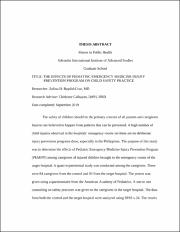| dc.description.abstract | The safety of children should be the primary concern of all parents and caregivers. Injuries are believed to happen from patterns that can be prevented. A high number of child injuries observed in the hospitals’ emergency rooms yet there are no deliberate injury prevention programs done, especially in the Philippines. The purpose of this study was to determine the effects of Pediatric Emergency Medicine Injury Prevention Program (PEMIPP) among caregivers of injured children brought to the emergency rooms of the target hospital. A quasi-experimental study was conducted among the caregivers. There were 84 caregivers from the control and 83 from the target hospital. The pretest was given using a questionnaire from the American Academy of Pediatrics. A one to one counseling on safety practices was given to the caregivers in the target hospital. The data from both the control and the target hospital were analyzed using SPSS v.24. The results
ii
showed that fall injury was the most prevalent injury in both the target (55.4%) and the control hospital (53.6%), followed by burn injuries with 25.3% in the target and 25% in the control hospital. Road accident was 15% in the target and 16.7% in the control hospital. Ingestion was the least (4.8%) in the control and 3.6% in the target hospital of all the injuries. The level of safety practices of the caregivers in the pretest was poor in both the control and the target hospital in the pretest. In addition, ANOVA showed significant differences in the pretest (M = 3.21, SD = 1.42) t(13) = -4.846,p = 0,000 and the posttest (M = 7.21, SD = 2.64) of road accident injury and ingestion injury pretest (M = 1.75, SD = 0.96) and the posttest (M = 3.25, SD = 0.50) t(3) =-5.196, p = .014 in the control hospital. In the target hospital, the pretest and the posttest showed significant difference in fall (p = .001), road accidents (p = .000), burn injuries (p = .029) and ingestion injury (p = .020). There was no significant difference in safety practices in the target hospital taking into consideration the moderating effects of the age, gender, and socioeconomic status. This study concludes that PEMIPP is an effective program for increasing the level of safety practices among caregivers in terms of fall, burn, road accidents, and ingestion injury. | en_US |

